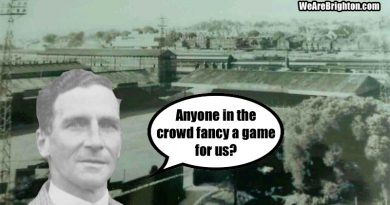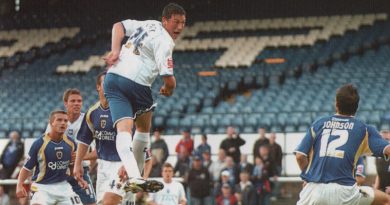When Brighton won the Charity Shield to become champions of England
Brighton and Hove Albion, champions of England. Back in 1910, little old Brighton were unofficially crowned the best team in the land when they shocked Aston Villa to win the Charity Shield. It remains the Albion’s greatest ever day.
And let’s face it, it’s unlikely to ever be topped. Short of winning an FA Cup or a Premier League title, we’re unlikely to become the centre of English football again anytime soon, as was the case on Monday 5th September 1910 at Stamford Bridge.
Back then, the Charity Shield wasn’t just a glorified pre-season friendly between the league winners and the FA Cup holders. Football you see was split into two, almost regional leagues.
The Southern League did exactly what it said on the tin. The Football League meanwhile was considered the better competition, seeing as it was the original and best and encompassed all of the sport’s founder members, most of whom could be found in ghastly northern towns. The likes of Arsenal and some of the bigger clubs from the south were also memebers.
Until 1920, when the Football League absorbed the Southern League, the two remained very separate. The Charity Shield was the annual meeting of the Football League champions and the Southern League champions – which ultimately decided who the best team in the land were.
Brighton enjoyed an extraordinary 1909-10 season, completing a league and cup double. Jack Robson’s side won the title by five clear points from Swindon Town and defeated Watford in the Southern Professional Cup Final. Just nine years after the club’s founding in the Seven Stars pub in Brighton, the Albion were well and truly on the football map.
The great Aston Villa meanwhile had just been crowned Football League champions for the sixth time. They would provide the opposition for Brighton in the Charity Shield Final at Chelsea’s home ground with the game taking place four months after the completion of the 1909-10 campaign.
The long wait to face Villa only added to the excitement. Even with the cricket season in full swing, all anyone could talk about in the pubs of Sussex over the course of the summer was the upcoming meeting with Villa.
Sussex’s non-football folk were getting swept up in it too and when the big day arrived, hundreds of supporters clad in blue and white set off from Brighton Station to the big smoke.
Even over 100 years ago, going to watch the Albion was done more in hope than expectation. Not many people outside Brighton gave Robson and his players a chance.
After all, Villa were the biggest club in the land from the superior Football League. The Albion’s Charlie Webb described it as “David versus Goliath”.
Brighton turned up at Stamford Bridge in horse drawn carriages after a train journey made alongside hoards of fans. On arrival, it became clear that no Villa supporters had even entertained the idea of defeat to the Southern League minnows.
The Albion team were said to be nervous beforehand but once they stepped out onto the pitch in front of a crowd of 13,000 they settled. From the first whistle, Villa knew that they were in for a battle if they were to secure what most people had assumed would be a straightforward victory.
Brighton’s football was described by the media as not being as pretty to watch as Villa’s because they did not keep the ball on the floor quite so skilfully as their rivals, but the Albion did have more dash and consistency.
We wonder if 1910s Twitter would have exploded with rage at a journalist having the nerve to criticise Brighton’s style in the same way that 2019 Twitter does?
Bob Whitting in the Brighton goal was said to have so little to do that you could count the saves he made on the fingers of one hand. In front of him, Fred Blackman and captain Joe Leeming were giving their best.
Brighton went close early on but Bill Hastings fired over the bar after going around the Villa goalkeeper. The Albion’s wonderfully named Bullet Jones hit a post before Villa did have the ball in the back of the net when England international Bert Hall scored direct from a corner.
Fortunately for the Seagulls, this was illegal in 1910 – another player had to touch the ball before it went in, much like the throw-in rule we know today – and so the Albion lived to fight another day. Brighton responded with Webb and Jones both hitting the side netting before the half was out.
Brighton had more of the ball in the second half but had to wait until 18 minutes before the end to make it count. Bert Longstaff swung over a corner which Villa keeper Arthur Cartlidge tried to claim.
He got into a bit of mess however and a goalmouth scrambled ensured. Hastings eventually managed to get hold the ball, laying it off to Webb. Webb moved backwards to lessen the angle, danced around a couple of flaying defenders before firing high into the goal for 1-0.
The Sussex Daily News described the noise that greeted the goal as being “something to remember.” Villa threw players forward after that and Robson responded by dropping Webb in as an additional defender, like a 1910 version of Adam Virgo.
As the realisation began to dawn on Villa that they were about to be the victims of an almighty shock, they began adopting some rather rough tactics.
Nothing that Villa tried worked though. The Albion saw out the remainder of the match and upon the final whistle, the crowd surged onto the pitch to celebrate.
Mr Charles Crump, the vice President of the Football Association, presented Leeming with the trophy, which he lifted to deafening cheers. Brighton had won the Charity Shield – the Albion were champions of England.
The party though was only just beginning. The team arrived back in Brighton at 11.30pm that evening, with the station packed to the rafters. Outside was equally busy. When they alighted from the train, people began waving their hats around in the air.
Because of the crowds wishing to offer a heroes welcome, the players had to escape the crush by crossing the platform behind the barriers before boarding a train bound for Hove. Webb had a new addition to the family to attend to; his daughter Joyce was born the same day.
The fans meanwhile dispersed to carry on the celebrations long into the night, presumably in whatever was the early 20th century version of Molly Malone’s.
It was a party that went down in the town’s history and was talked about for many years, similar to the scenes that greeted Chris Hughton’s side’s promotion to the Premier League in 2017.
All three of the Albion’s trophies from that 1909-10 season were put on display in the window of Mr Horton-Stephens’ hosiery shop at 42 Western Road – now Card Factory and the Cancer Research Charity Shop – where they received great attention from the general public.
17 days after the game, a smoking-concert was held at the Dome where the Albion players were presented with further medals by both the Mayor of Brighton, Alderman Edward Geere and the Mayor of Hove, Captain Fraser.
Supporters had also been asked to donate money to the Brighton player’s testimonial fun in recognition of their achievements in winning the Charity Shield and this was distributed evenly among the squad.
Hopefully, Paul Barber isn’t reading this and picking up any ideas about Albion supporters contributing to player bonuses come the end of the season.
In historical terms, Brighton beating Aston Villa was the only time that a Southern League outfit defeated their Football League counterparts in the Charity Shield.
There was great excitement that the name of the Albion would be engraved on a piece of silverware alongside the likes of footballing giants Manchester United and Newcastle United.
Five days later after the over Villa and the champions of England returned to their bread and butter of the Southern League. The result? A 2-1 defeat away at Watford. Best team in the land but can’t win away at Watford? Classic Brighton.




